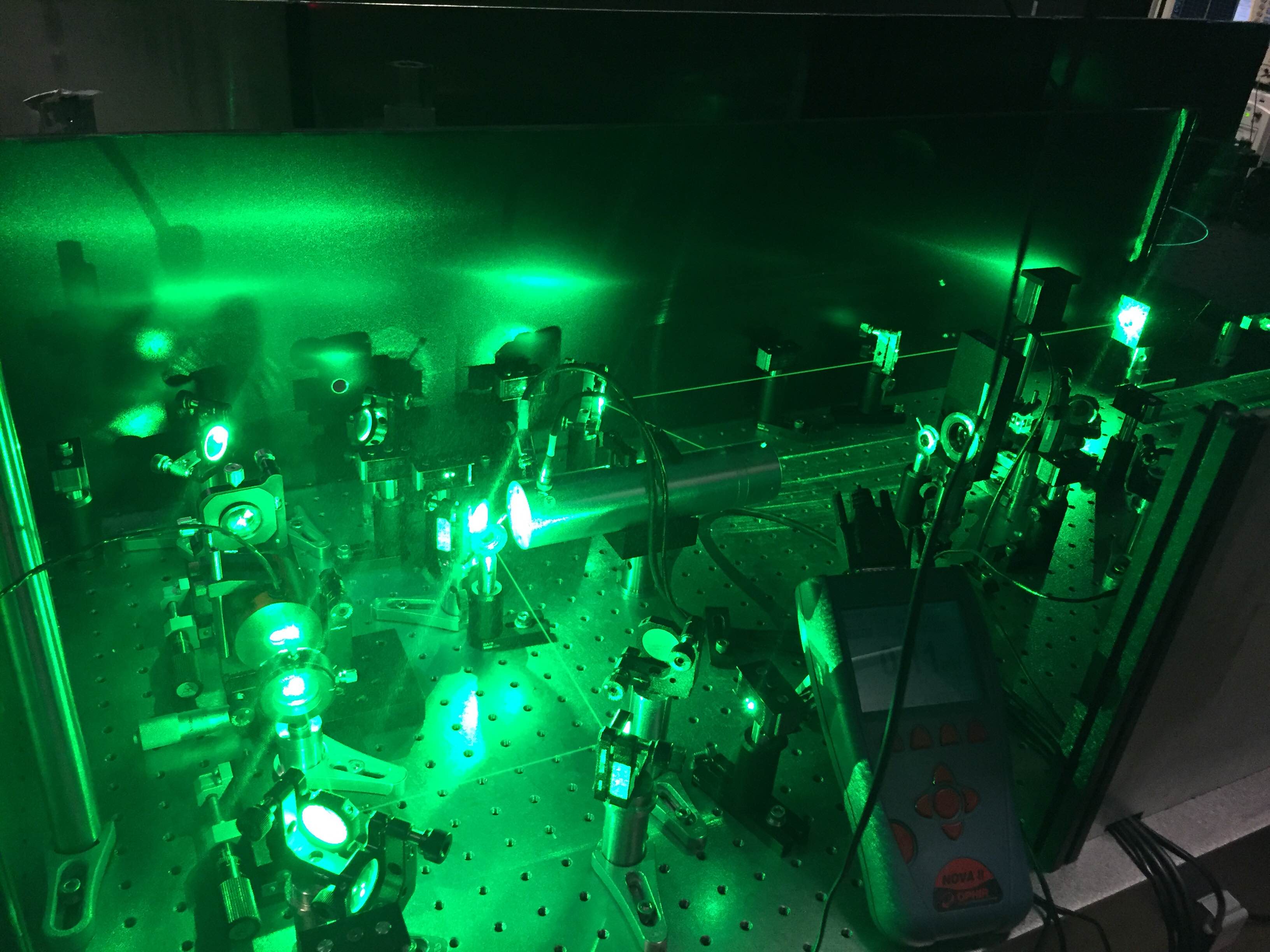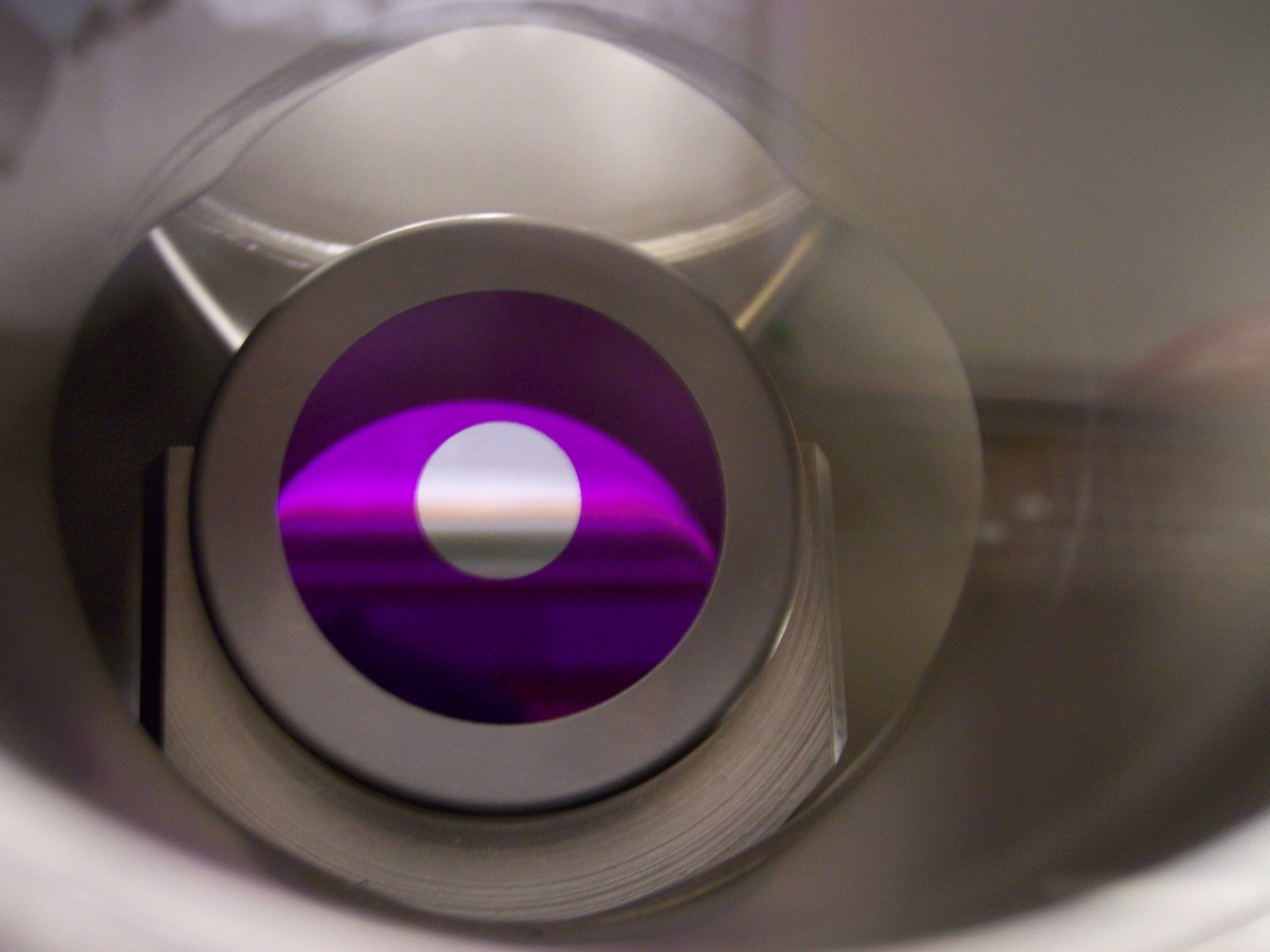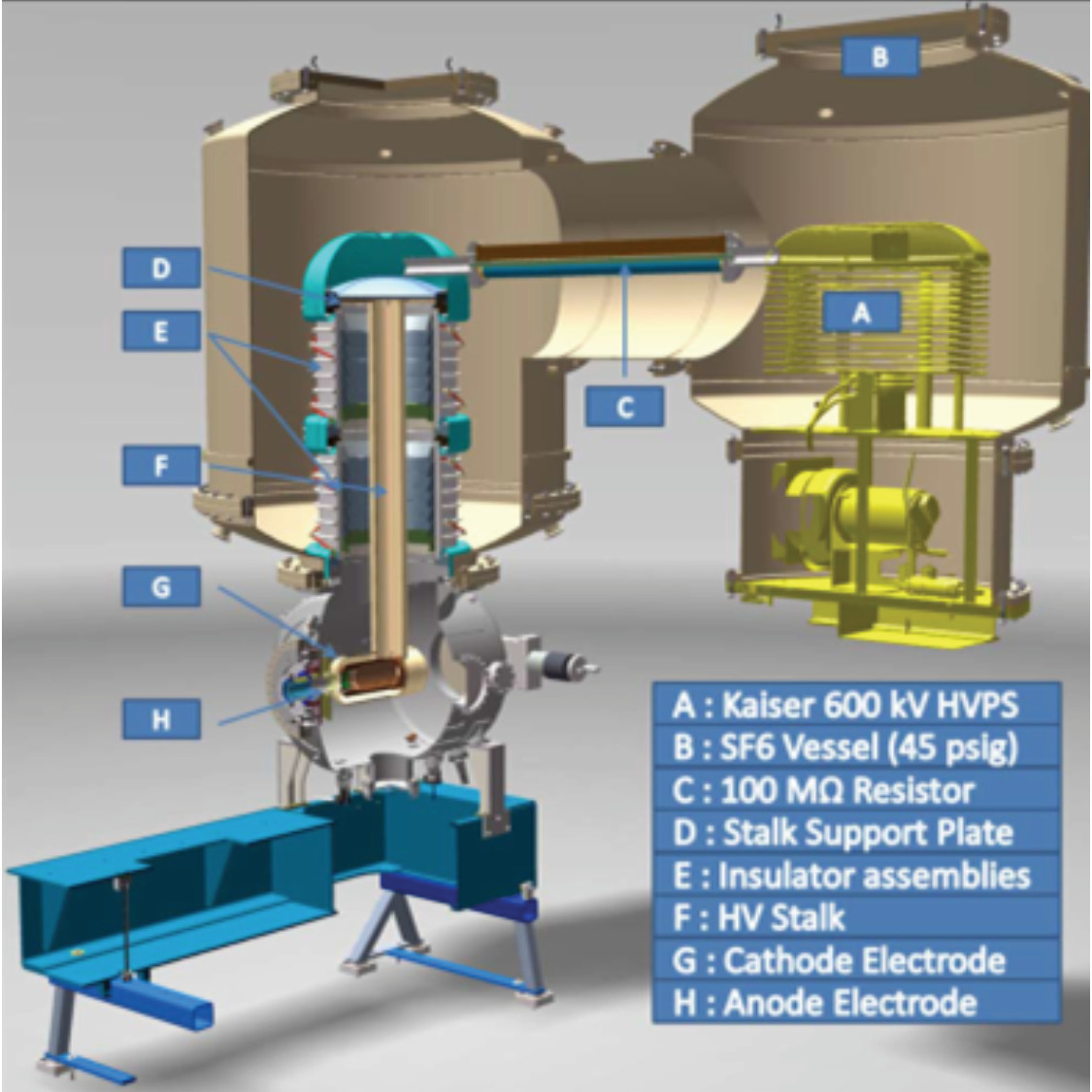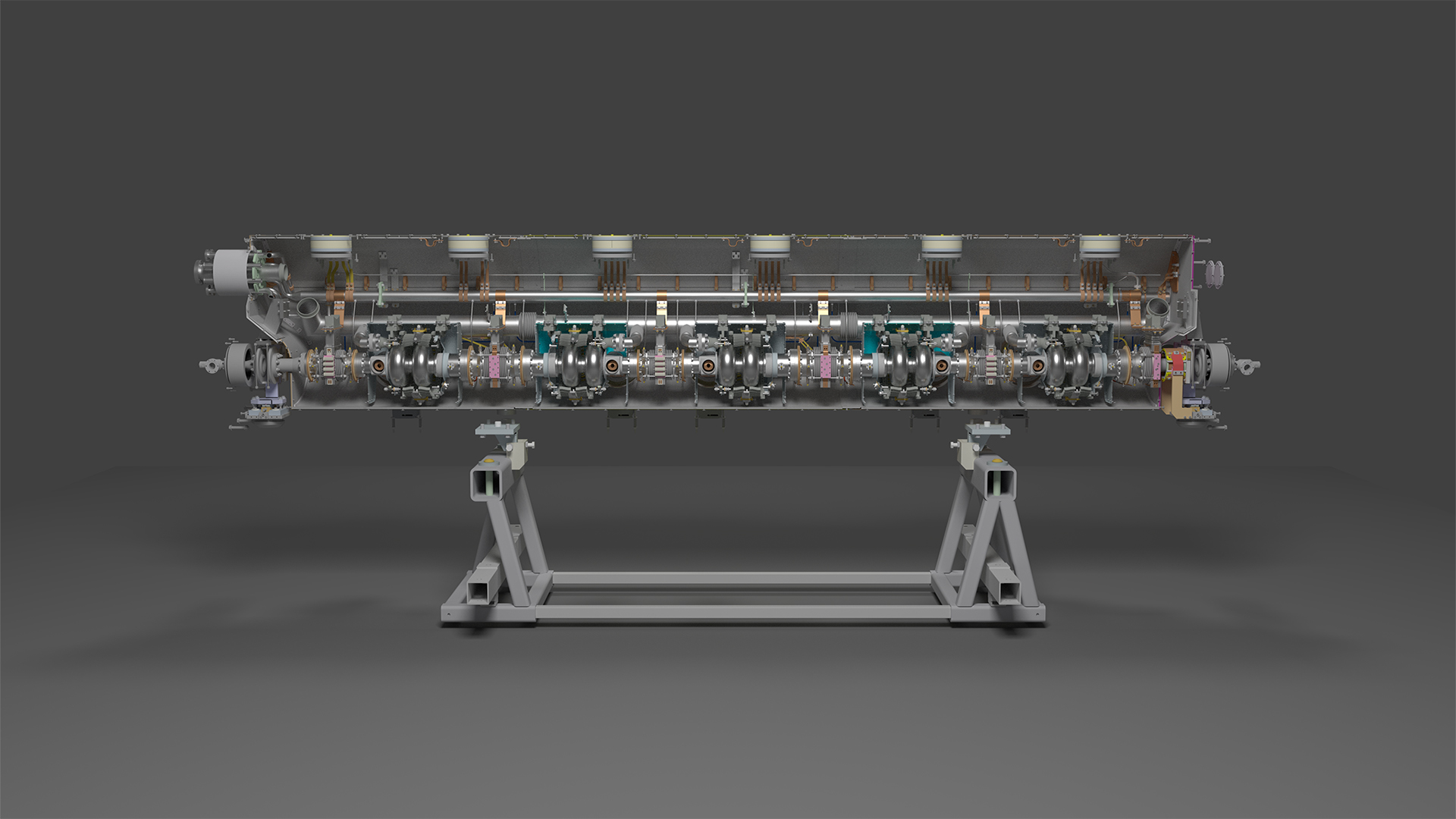Photoinjector
The Cornell Photoinjector is the world's brightest electron source, holding the
world record for average current, while being able to demonstrate
cathode-limited emittance preservation. The primary sections of the photoinjector are a high power pulsed laser system, a high quantum-efficiency cathode, a high voltage DC electron gun, focusing (transverse and longitudinal), and accelerating cavities.
Laser

The photoinjector laser system uses a combination of home-built and commercial fiber oscillators ranging in repetition rate from 50 Mhz to 1.3 GHz. The oscillators produce picosecond pulses of 1 micron wavelength light, which are amplified up to average powers in the 10-100 watt level. The laser is then frequency doubled to 520 nm wavelength (green), pulse shaped, and then sent to the cathode. The power of a photoinjector is that the initial distribution of electrons is determined by the shape of the incoming laser beam. So, by fine-tuning the properties of the laser, you also can fine-tune the properties of the initial electron beam.
Cathode

Cornell has a dedicated research effort towards improving cathodes for high-brightness electron sources. We pioneered the usage of high-quantum efficiency multi-alkali cathodes, improving the lifetime of the cathode by an order of magnitude compared to GaAs, the prior state-of-the-art. Cathodes are prepared in Newman laboratory, and then carried across campus in a UHV-capable "vacuum suitcase", and then inserted inside of the electron gun.
DC Gun

After shining the laser onto the cathode, the electrons are accelerated to 80% of the speed of light in a 400 kV DC electrode, which is only 5 cm long. But, in order to support such a large voltage and potentially high current, a large ceramic insulator and separate high voltage / high current power supply are required. The current version of the Cornell gun also has a segmented insulator design with metal guard rings the protect the ceramic insulator from punch-through from field emission, which was the primary limiting factor in previous gun designs. This gun has been processed up to 425 kV under vacuum, and has typical operation at 400 kV.
Focusing
A combination of a solenoid lens magnet pair to focus transversely, and a normal conducting buncher cavity to focus longitudinally is used to overcome the beam's natural tendency to expand from electron repulsion. The buncher has been processed up to 90 kV, and is typically operated at 50-70 kV.
Injector Cryomodule

The Injector Cryomodule, or ICM, is a series of 5 two cell 1.3 GHz superconducting RF cavities with twin 50 kW input couplers, with microwave power delivered from high-power klystrons. The input power couplers are adjustable to allow impedance matching for a variety of different beam currents, with a typical Q of 5x10^9 and an external Q in the range of 10^5. The ICM is capable of a total energy gain of around 15 MeV, though limited by the input couplers for very high current beams. It is typically used at a more modest 5 MeV energy gain.
-- Main.RichardRyan - 07 Dec 2016
 Cornell has a dedicated research effort towards improving cathodes for high-brightness electron sources. We pioneered the usage of high-quantum efficiency multi-alkali cathodes, improving the lifetime of the cathode by an order of magnitude compared to GaAs, the prior state-of-the-art. Cathodes are prepared in Newman laboratory, and then carried across campus in a UHV-capable "vacuum suitcase", and then inserted inside of the electron gun.
Cornell has a dedicated research effort towards improving cathodes for high-brightness electron sources. We pioneered the usage of high-quantum efficiency multi-alkali cathodes, improving the lifetime of the cathode by an order of magnitude compared to GaAs, the prior state-of-the-art. Cathodes are prepared in Newman laboratory, and then carried across campus in a UHV-capable "vacuum suitcase", and then inserted inside of the electron gun.
 After shining the laser onto the cathode, the electrons are accelerated to 80% of the speed of light in a 400 kV DC electrode, which is only 5 cm long. But, in order to support such a large voltage and potentially high current, a large ceramic insulator and separate high voltage / high current power supply are required. The current version of the Cornell gun also has a segmented insulator design with metal guard rings the protect the ceramic insulator from punch-through from field emission, which was the primary limiting factor in previous gun designs. This gun has been processed up to 425 kV under vacuum, and has typical operation at 400 kV.
After shining the laser onto the cathode, the electrons are accelerated to 80% of the speed of light in a 400 kV DC electrode, which is only 5 cm long. But, in order to support such a large voltage and potentially high current, a large ceramic insulator and separate high voltage / high current power supply are required. The current version of the Cornell gun also has a segmented insulator design with metal guard rings the protect the ceramic insulator from punch-through from field emission, which was the primary limiting factor in previous gun designs. This gun has been processed up to 425 kV under vacuum, and has typical operation at 400 kV.
 The Injector Cryomodule, or ICM, is a series of 5 two cell 1.3 GHz superconducting RF cavities with twin 50 kW input couplers, with microwave power delivered from high-power klystrons. The input power couplers are adjustable to allow impedance matching for a variety of different beam currents, with a typical Q of 5x10^9 and an external Q in the range of 10^5. The ICM is capable of a total energy gain of around 15 MeV, though limited by the input couplers for very high current beams. It is typically used at a more modest 5 MeV energy gain.
-- Main.RichardRyan - 07 Dec 2016
The Injector Cryomodule, or ICM, is a series of 5 two cell 1.3 GHz superconducting RF cavities with twin 50 kW input couplers, with microwave power delivered from high-power klystrons. The input power couplers are adjustable to allow impedance matching for a variety of different beam currents, with a typical Q of 5x10^9 and an external Q in the range of 10^5. The ICM is capable of a total energy gain of around 15 MeV, though limited by the input couplers for very high current beams. It is typically used at a more modest 5 MeV energy gain.
-- Main.RichardRyan - 07 Dec 2016
